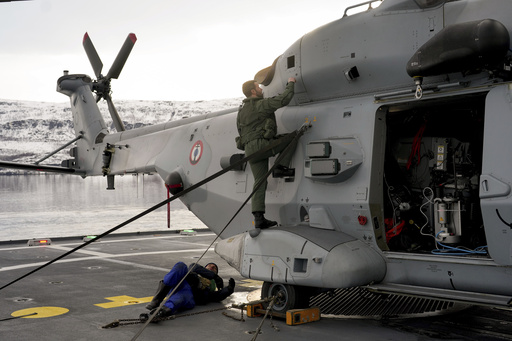ABOARD THE FRENCH FRIGATE NORMANDIE (AP) — The French navy frigate, bristling with weaponry and powering through frigid Norwegian seas not so far from Russia, awoke at 7:30 a.m. sharp to what, in the circumstances, was a surreal sound.
The 1967 “ Summer of Love ” hippie anthem “San Francisco (Be Sure to Wear Flowers in Your Hair)” was playing over the warship’s public address system. Singer Scott McKenzie’s voice reverberated through the passageways starting to bustle with sailors clutching coffee mugs: “All across the nation, such a strange vibration, people in motion.”
It was a slice of Americana rousing one of France’s most modern fighting vessels, beginning another day under Italian command, in war games involving 13 nations.
And that, in a nutshell, is NATO: a multinational alliance built around the idea that its 32 countries spread across three continents could turn their diversity into strength and fight as one if the need arose.
The Nordic Response 2024 exercises — bringing together more than 20,000 soldiers with different languages, equipment, habits and histories — are intended to foster the teamwork necessary for the alliance to function.
They are training with the knowledge that Russia and other potential adversaries are watching for any weaknesses in NATO defenses and unity.
Among the nations drilling is Sweden, NATO’s 32nd and newest member. Its induction last week and the addition of Finland last year dramatically illustrated how Russia’s invasion of Ukraine, now in its third year, shifted Europe’s post-Cold War security landscape.
From shunning military alliances, the two Nordic nations reached for NATO’s security umbrella and its guarantee that an attack on any one member would be considered as an attack on them all.
In the frozen extremes of northern Finland, Norway and Sweden, the NATO drills are a test for troops and their fighting machines. Participating nations are Belgium, Britain, Canada, Denmark, Finland, France, Germany, Italy, the Netherlands, Norway, Spain, Sweden and the United States.
The nearly two weeks of drills conclude this week. They are part of a months-long program of NATO maneuvers dubbed Steadfast Defender 24 that are its biggest since the Cold War, with 90,000 troops. The alliance says the intention is “to demonstrate NATO’s ability to defend every inch of its territory” — an unmistakable signal to Russia.
Certainly, participating troops suspect that Russia is watching.
Aboard the French frigate Normandie, the crew of 146 scrambled to battle stations when an unknown aircraft that came from the direction of Russia strayed too close for comfort last week, in international airspace north of the warship’s Nordic Response patrol zone in Arctic waters.
The Normandie’s commanding officer, Capt. Thomas Vuong, told Associated Press journalists aboard that the flight appeared to have been a Russian test of NATO readiness. Norway scrambled F-35 fighters to intercept the aircraft, which headed back in Russia’s direction, he said.
NATO regularly scrambles jets to scope Russian flights, taking to the skies for more than 500 interceptions in 2022. The number dropped but was still more than 300 encounters in 2023, the Brussels-headquartered alliance says.
“These are maneuvers that are fairly standard, maneuvers where the Russians test the procedures,” Vuong said, speaking exclusively to AP. Russia has “resources in the skies, at sea that are employed and which enable them to test the alliance’s defenses.”
Listening to the NATO drills’ radio traffic gives a flavor of the melting pot of nations and cultures in the transatlantic organization. Communications are in English but accents betray the array of nationalities: French, Italian, German, British, American and more.
“We have a technical vocabulary and everyone uses it,” said Lt. Olivier, pilot of the Normandie’s submarine-hunting NH90 helicopter. The French military withheld his family name for security reasons.
“As you can hear, it’s not perfect English,” he said. “But since it’s always the same technical words, everyone is able to understand the picture, the situation, and to react if necessary.”
In the decades since its founding by 12 countries in 1949, NATO has worked to standardize procedures and equipment to enable troops to work and, if necessary, fight together more readily. The flight deck of the Normandie, for example, is equipped to receive other countries’ helicopters.
The alliance “functions because there are military headquarters developing interoperability within NATO, which means we ensure that we have systems that function together, that communicate together,” Vuong said. “This gives us the capability to operate together when we meet at sea.”
Vuong added that he senses “a real willingness” from alliance sailors “to make sure we raise our standard within NATO as high as possible.”
Lt. Sebastian, a German navy officer who hitched a ride aboard the Normandie to make a port call during the exercises, said working with and learning from other NATO nations helps alliance troops improve. He wouldn’t give his family name.
“Of course you can do your job on your own, going to sea with just one ship,” he said. But “NATO means a whole group of abilities and that is what we train here, to use all the abilities combined together.”
___
AP coverage of NATO at https://apnews.com/hub/nato and of Ukraine at https://apnews.com/hub/russia-ukraine


